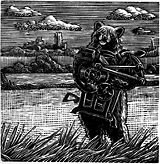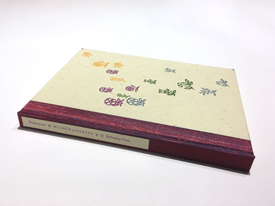| |
||||||||
Past Publications

Wood engraving by Andy English
(from The Eve of St. Agnes, 2003)
Many of the titles published by Barbarian Press in the past are now out of print. Descriptions and publication details of some of those titles are available here for your perusal.
Please note that all of these books are
OUT OF PRINT
|
Click on thumbnail image above |
Musick in partes:
Songs & Poems from Shakespeare’s Plays
Published to mark the Quatercentenary of Shakespeare’s death on what was probably his 52nd birthday: 23 April 1616. With notes and glossary, and multiple wood engravings by John Lawrence
August 2017
The sixteenth and seventeenth centuries positively revelled in music. The sudden development of new instruments and styles of musical composition in the early renaissance had arguably created as profound a shift from the music of the mediaeval period as the second Viennese school of Schoenberg, Berg, and Webern in the early twentieth century did from the late Romantic music of Mahler, Richard Strauss, and Wagner. The period from 1550 through Shakespeare’s life and on into the seventeenth century saw hundreds of composers producing songs, lute music, consort music, dances, and both liturgical and secular polyphonic choral music, to say nothing of the advent of opera in the works of Peri and Monteverdi in Milan around 1600. The first stirrings of what eventually became the orchestra are discernable in the wide range of instruments—viols, rebecs, hurdy-gurdies, lutes, guitars, citterns, trumpets, cornetts, sackbuts, serpents, recorders, flutes, crumhorns, curtals, shawms, racketts, regals, organs—which were used in multiple combinations in works such as Tielman Susato’s Danserye and Michael Praetorius’ Terpsichore.
Shakespeare’s theatre assumed music to be a natural part of almost any performance. Roughly two thirds of his thirty-eight plays include song texts, and many of those have become established in the canon of lyric poetry in English in their own right. The Elizabethan stage moreover included what was called a ‘minstrels’ gallery’ above the stage, and we know that music was played at dramatic points during performances to create moods or enhance special effects. To give only two examples: in The Tempest ‘Soft music’ is mentioned in a stage direction before the masque in Act 4; and after the reconciliation scene in Pericles a direction calls for ‘Celestial music’—and this is to say nothing of the innumerable ‘sennets,’ sounding trumpets, and martial music which abound. In this 400th anniversary year of Shakespeare’s death it occurred to us to celebrate the music in the plays by way of their songs, and in Musick in parteswe are presenting over forty songs and two or three poems from every period of his plays, from The Two Gentlemen of Verona (1594) to The Two Noble Kinsmen (1613).
As is our practice, the texts are presented in the original spellings of the First Folio or Quarto texts, and there are notes about the poems and a glossary of particularly obscure words. The book is illustrated with many wood engravings by John Lawrence. Given John’s delightful penchant for tiny thumbnail engravings as well as rich full-page illustrations, we turned him loose on the manuscript and are delighted at what he has delivered. John’s work is exuberant and fresh, and we have wanted to work with him ever since we first encountered it nearly fifty years ago. We met him in 1984, and every time we have met since we have agreed that we really ought to do something together. Let it be recorded that we do, eventually, get to things!
![]()
Musick in partes arrived today. Another marvellous production! I especially like your use of the floriated dropped capitals; they accord very well with John Lawrence’s vignettes. The engravings are fantastic (and I mean that in both the broad and narrow senses); they are more symbolic or iconographic than illustrative, and their relative simplicity (almost coarseness) and whimsy suit the songs and verse much better than something representational would.
Jacob Quinlan, Bookseller and SubscriberMusick in Partes has safely arrived and I could not have been more delighted with it. It really is a joyful book, which I suspect is contributed to in no small measure by the decision to print a sprinkling of the woodcuts in colour and by the delightful printed paper on the front board. Not quite sure why, but I had never realised before how much John Lawrence's woodcuts had a feel of those of that time, albeit, I suspect, with much more of a sense of humour. I especially like the frontispiece.
Richard Barnett, SubscriberI received my copy of Musick in partes: Songs & Poems from Shakespeare’s Plays, and it is same old, same old - another lovely publication and, in my case, a welcome respite from the insane asylum that was formerly known as the United States of America. When you print and publish a steady stream of elegant, beautiful books, ‘same old, same old’ is commendable, not objectionable. Keep on doing what you’re doing! The Shakespeare book of songs and poems is delightful and I am still immersed in your prior book of Cavafy’s poetry, which filled a gaping void in the realm of modern private press books (1890 to present).
Jack Katz, M.D., SubscriberThank you so much for the Shakespeare which is magnificent.
Murray Rosen, Subscriber
![]()
Musick in partes: Songs & Poems from Shakespeare’s Plays is published in an edition of 110 copies, of which 60 constitute the Deluxe state, and 50 the Regular, with 10 copies hors commerce. Subscribers’ copies are reserved.
DELUXE STATE: 60 COPIES. The text is set in Poliphilus and Blado, with Duensing and ATF Ornamental caps for display, in black, red, green, and violet, and several other colours on Zerkall Book White mouldmade paper. The engravings by John Lawrence are printed from the wood, with some detailed spots from the larger engravings printed from photopolymer plates. The book is quarter bound in maroon morocco with printed paper boards from printer’s ornaments, contained in a plum silk slipcase with a portfolio containing strikes of the engravings.
PRICE: C$690. OUT OF PRINT
REGULAR STATE: 50 COPIES. As the Deluxe state, but quarter bound with a plum silk spine with printed paper boards and printed paper label. Not slipcased.
PRICE: C$485.
5 additional copies of each state, designated hors commerce, are reserved for the use of the press.
Both states are bound by Alanna Simenson at the Mad Hatter Bookbinding Company, Sooke, B.C.
Visit our Ordering page to order this title.
